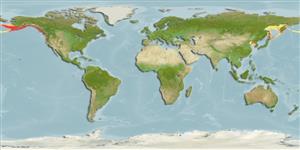Classification / Names
Common names from other countries
Main reference
Size / Weight / Age
Max length : 34.0 cm TL male/unsexed; (Ref. 56527); common length : 20.0 cm TL male/unsexed; (Ref. 7354); max. reported age: 5 years (Ref. 12193)
Length at first maturity
Lm ?, range 15 - 16 cm
Environment
Marine; freshwater; brackish; pelagic-neritic; anadromous (Ref. 51243); depth range 0 - 300 m (Ref. 6793)
Climate / Range
Temperate, preferred 7°C (Ref. 107945); 61°N - 36°N
Distribution
North Pacific: west of Saint Matthew Island and Kuskokwim Bay in the Bering Sea, and Bowers Bank in the Aleutian Islands to Monterey Bay, California, USA. Populations from northern British Columbia are separate from those in the Fraser River (Ref. 10276).
Countries | FAO areas | Ecosystems | Occurrences | Introductions
Short description
Dorsal
spines
(total): 0;
Dorsal
soft rays
(total): 10-13;
Anal
spines: 0;
Anal
soft rays: 18 - 23;
Vertebrae: 65 - 72. Distinguished by the large canine teeth on the vomer and 18 to 23 rays in the anal fin (Ref. 27547). Adipose fin sickle-shaped; paired fins longer in males than in females; all fins with well developed breeding tubercles in ripe males which are poorly developed or absent in females (Ref. 27547). Adult coloration is brown to blue on back and top of the head, the sides lighter to silvery white, and the ventral surface white; speckling is fine, sparse and restricted to the back; peritoneum is light with black speckles (Ref. 6885). Fins transparent, pectorals and caudal often dusky (Ref. 27547). During spawning, male fish has a distinctly raised ridge along the middle of the body and a rough texture, differentiating it from the female which is smaller, smoother and shinier.
IUCN Red List Status (Ref. 115185)
Threat to humans
Harmless
Human uses
Fisheries: commercial
Tools
Special reports
Download XML
Internet sources
Estimates of some properties based on models
Phylogenetic diversity index
PD50 = 1.0000 many relatives (e.g. carps) 0.5 - 2.0 few relatives (e.g. lungfishes)
Trophic Level
3.3 ±0.37 se; Based on food items.
Resilience
Medium, minimum population doubling time 1.4 - 4.4 years (tm=2-6; tmax=5; K=0.34; Fec=17,000-60,000 Musick et al. 2000 (Ref. 36717))
Vulnerability
Low to moderate vulnerability (33 of 100)
Price category
